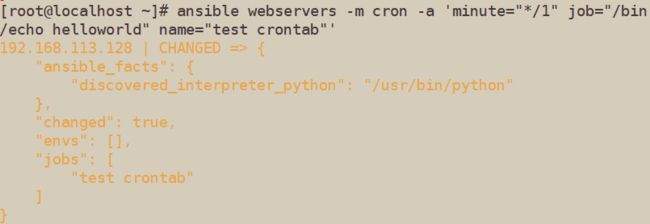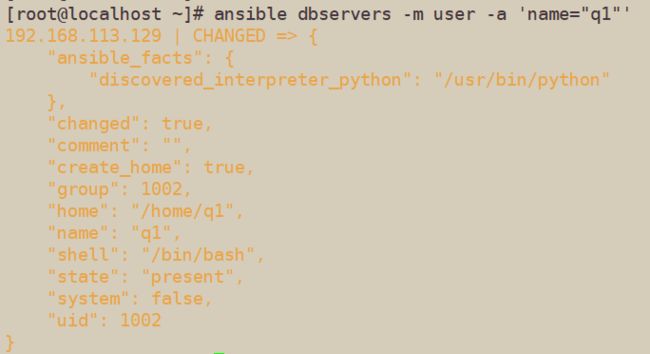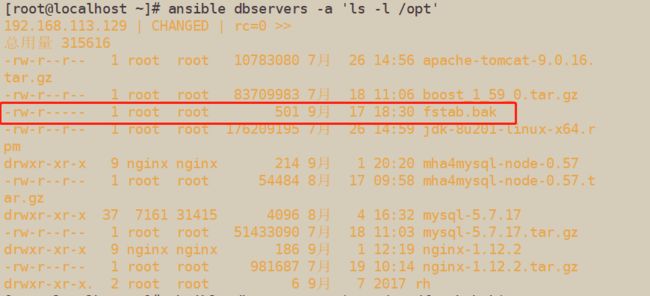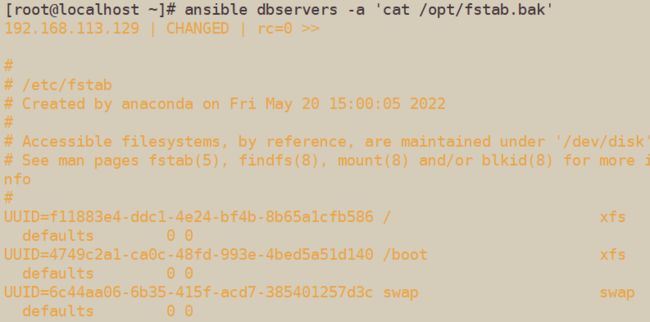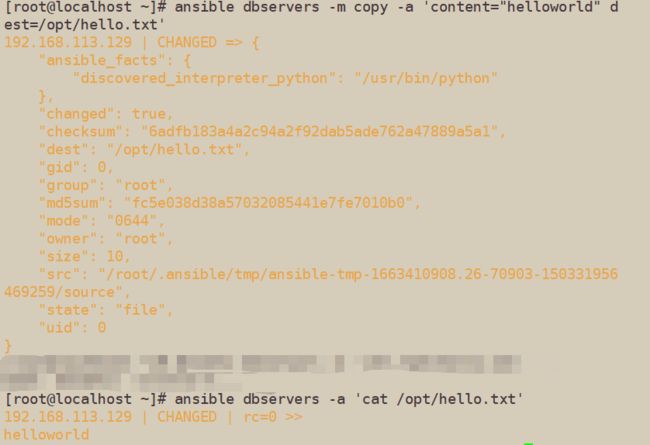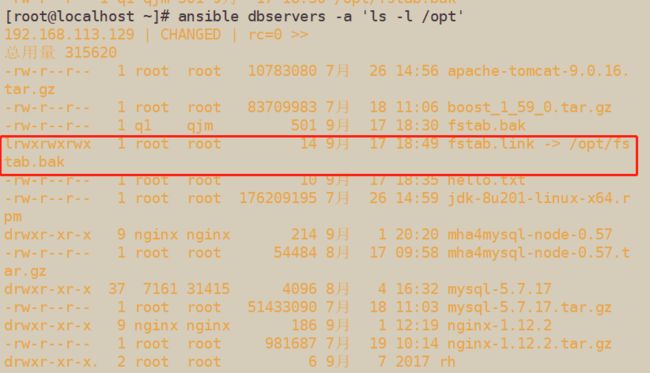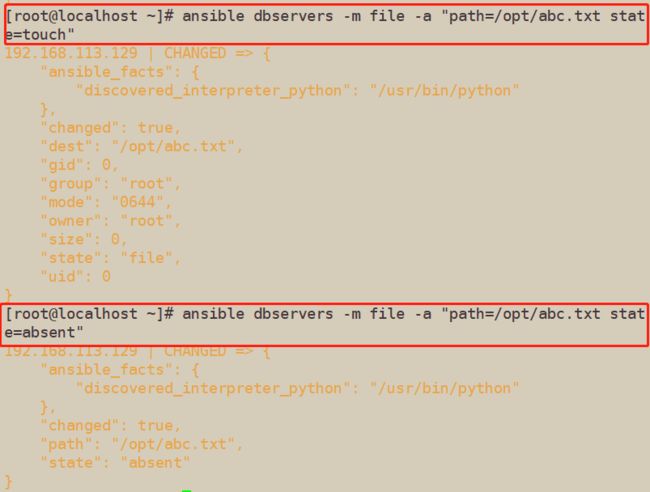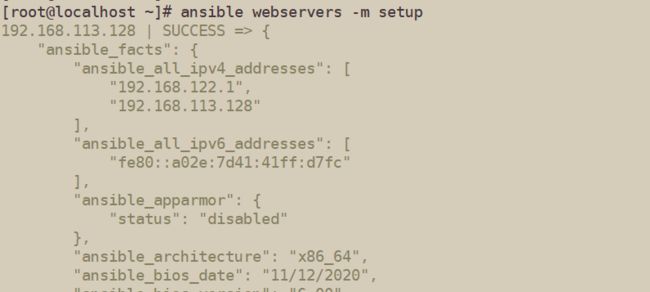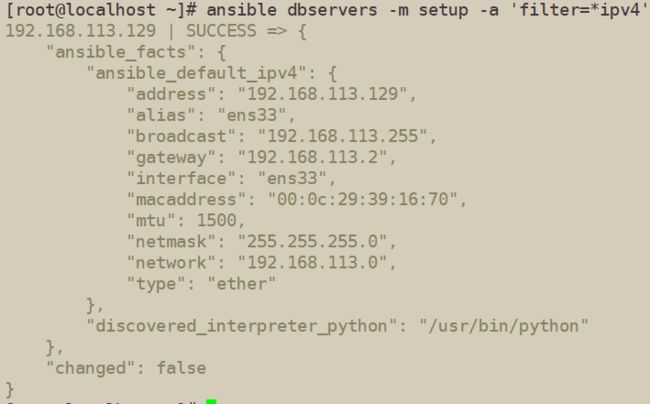Ansible 概述与模块基本操作
文章目录
- 一、Ansible 概述
-
- 1.Ansible 的特点
- 2.Ansible 工作机制
- 二、Ansible 环境安装及部署
- 三、Ansible 命令行模块
-
-
- 1.command 模块
- 2.shell 模块
- 3.cron 模块
- 4.user 模块
- 5.group 模块
- 6.copy 模块
- 7.file 模块
- 8.hostname 模块
- 9.ping 模块
- 10.yum 模块
- 11.service/systemctl 模块
- 12.script 模块
- 13.setup 模块
-
- 四、inventory 主机清单
-
-
- 1.inventory 中的变量
- 2.主机变量
- 3.组变量
- 4.组嵌套
- 4.组嵌套
-
一、Ansible 概述
-
Ansible是一款为类Unix系统开发的自由开源的配置和自动化工具
-
它用Python写成,类似于saltstack、Puppet、CHef,但是有一个不同和优点是我们不需要在节点中安装任何客户端
-
它使用SSH来和节点进行通信。Ansible基于 Pthon paramiko 开发,分布式,无需客户端,轻量级,配置语法使用 YMAL 及 Jinja2模板语言,更强的远程命令执行操作
-
Ansible官方网站:https://www.ansible.com/,红帽公司于2015年10月收购了ansible,而ansible成立于2013年
-
Ansible能批量配置、部署、管理上千台主机。比如以前需要切换到每个主机上执行的一或多个操作,使用Ansible 只需在固定的一台Ansible控制节点上去完成所有主机的操作
-
使用者在使用时,在服务器终端输入命令或者playbooks,会通过预定好的规则将playbook拆解为play,再组织成ansible可以识别的任务,调用模块和插件,根据主机清单通过SSH将临时文件发给远程的客户端执行并返回结果,执行结束后自动删除
1.Ansible 的特点
1.部署简单,没有客户端,只需在主控端部署Ansible环境,被控端无需做任何操作
2.模块化:调用特定的模块,完成特定任务
3.默认使用SSH协议对设备进行管理
4.主从集中化管理
5.配置简单、功能强大、扩展性强
6.支持API及自定义模块,可通过Python轻松扩展
7.通过Playbooks来定制强大的配置、状态管理
8.对云计算平台、大数据都有很好的支持
9.具有幂等性:一个操作在一个主机上执行一遍和执行N遍的结果是一样的
2.Ansible 工作机制
Ansible 在管理节点将 Ansible 模块通过 SSH 协议推送到被管理端执行,执行完之后自动删除,可以使用 SVN 等来管理自定义模块及编排
ansible是基于模块工作的,本身没有批量部署的能力,真正具有批量部署的是ansible所运行的模块,ansible只是提供一种框架。主要包括:
(1)连接插件connection plugins:负责和被监控端实现通信
(2)host inventory:指定操作的主机,是一个配置文件里面定义监控的主机
(3)各种模块核心模块、command模块、自定义模块
(4)借助于插件完成记录日志邮件等功能
(5)playbook:剧本执行多个任务时,非必需可以让节点一次性运行多个任务
由图可以看出Ansible的组成由以下模块组成:
Ansible: ansible的核心模块
Host Inventory:主机清单,也就是被管理的主机列表
Playbooks:ansible的剧本,可想象为将多个任务放置在一起,一块执行
Core Modules:ansible的核心模块
Custom Modules:自定义模块
Connection Plugins:连接插件,用于与被管控主机之间基于SSH建立连接关系
Plugins:其他插件,包括记录日志等
二、Ansible 环境安装及部署
| 服务器名 | IP | 安装的服务 |
|---|---|---|
| 管理端 | 192.168.113.125 | Ansible |
| 被管理端 | 192.168.113.128 | |
| 被管理端 | 192.168.113.129 |
#每台机器关闭防火墙核心防护
[root@localhost ~]# systemctl stop firewalld
[root@localhost ~]# systemctl disable firewalld
[root@localhost ~]# setenforce 0
1.管理端操作(192.168.113.125)
#1.安装ansible
#先安装epel源
[root@localhost ~]# yum install -y epel-release
[root@localhost ~]# yum install -y ansible
#2.查看anisble树形结构
[root@localhost ~]# yum install -y tree
[root@localhost ~]# tree /etc/ansible/
/etc/ansible/
├── ansible.cfg #ansible的配置文件,一般 无需修
├── hosts #ansible的主机清单,用于存储需要管理的远程主机的相关信息
└── roles #公共角色目录
#3.配置主机清单,最后一行添加
[root@localhost ~]# vim /etc/ansible/hosts
[webservers] #配置组名
192.168.113.128 #组里包含的被管理的主机IP地址或主机名(主机名需要先修改/etc/hosts文件)
[dbservers]
192.168.113.129
#4.配置密钥对验证
[root@localhost ~]# ssh-keygen -t rsa #一路回车,使用免密登录
#得先shh登陆下主机在使用下面命令,不然会报错
[root@localhost ~]# ssh 192.168.113.129
[root@localhost ~]# ssh 192.168.113.128
[root@localhost ~]# sshpass -p '123123' ssh-copy-id [email protected]
[root@localhost ~]# sshpass -p '123123' ssh-copy-id [email protected]
#sshpass -p是一种免交互方式
#测试免交互
[root@localhost ~]# ssh 192.168.113.129
[root@localhost ~]# ssh 192.168.113.128
三、Ansible 命令行模块
命令格式: ansible <组名> -m <模块> -a <参数列表>
ansible-doc -l #列出所有已安装的模块,按q退出
1.command 模块
#在远程主机执行命令,不支持管道,重定向等shell的特性
[root@localhost ~]# ansible-doc -s command #-s 列出指定模块的描述信息和操作动作,按q退出
#指定ip执行date
[root@localhost ~]# ansible 192.168.113.128 -m command -a 'date'
#指定组执行date
[root@localhost ~]# ansible webservers -m command -a 'date'
[root@localhost ~]# ansible dbservers -m command -a 'date'
#all代表所有hosts 主机
[root@localhost ~]# ansible all -m command -a 'date'
#如省略-m 模块,则默认运行command 模块,查看所有主机的目录
[root@localhost ~]# ansible all -a 'ls /'
[root@localhost ~]# ansible all -m command -a "chdir=/home ls ./"
#常用的参数:
chdir: 在远程主机上运行命令前,提前进入目录
creates: 在命令运行时创建一个文件,如果文件存在,则不会创建任务
removes:在命令运行时移除一个文件,如果文件不存在,则不会执行移除任务
executeble:指明运行命令的shell程序
#指定ip执行date
#指定组执行date,all代表所有hosts 主机
2.shell 模块
#在远程主机执行命令,相当于调用远程主机的shell进程,然后在该shell下打开一个子shell运行命令(支持管道符号等功能)
#列出指定模块的描述信息和操作动作,按q退出
ansible-doc -s shell
#指定dbservers组执行shell模块打印出ifconfig ens33第二行第二列,以空格分割截取第二列
[root@localhost ~]# ansible dbservers -m shell -a 'echo $(ifconfig ens33 | awk "NR==2 {print $2}") | cut -d " " -f2'
[root@localhost ~]# ansible dbservers -m shell -a 'echo $(ifconfig ens33 | awk "NR==2 {print \$2}")'
3.cron 模块
#在远程主机定义任务计划。其中有两种状态(state) : present表示添加 (可以省略) ,absent表示移除
ansible-doc -s cron
#常用参数:
minute/hour/day/month/weekday:分/时/日/月/周
job: 任务计划要执行的命令
name: 任务计划的名称
#指定那个组调用cron模块每一分钟执行一次helloworld并确定目录名字
[root@localhost ~]# ansible webservers -m cron -a 'minute="*/1" job="/bin/echo helloworld" name="test crontab"'
#查看计划任务
[root@localhost ~]# ansible webservers -a 'crontab -l'
#移除计划任务,假如该计划任务没有取名字,name=None即可,再次查看计划任务就没了
[root@localhost ~]# ansible webservers -m cron -a 'name="test crontab" state=absent'
eg:
##10号到20号,每两个小时执行一次hello
ansible webservers -m cron -a 'hour="*/2" day="10-20" job="/bin/echo hello" name="cron hello"'
ansible webservers -a 'crontab -l'
#移除相关效果
ansible webservers -m cron -a 'name="cron helli" state=absent'
4.user 模块
#用户管理的模块
ansible-doc -s user
#常用参数:
#name:用户名,必选参数
#state-present | absent:创建账号或者删除账号,present表示创建,absent表示删除
#system=yes|no:是否为系统账号
#uid:用户uid
#group:用户基本组
#shell:默认使用的shell
#move_home=yes|no:如果设置的家目录已经存在,是否将已经存在的家目录进行移动
#password:用户的密码,建议使用加密后的字符串
#comment:用户的注释信息
#remove=yes|no:当state=absent时, 是否删除用户的家目录
#例:指定dbservers组创建用户q1
[root@localhost ~]# ansible dbservers -m user -a 'name="q1"'
#查看是否创建
[root@localhost ~]# ansible dbservers -m command -a 'tail /etc/passwd'
#指定dbservers组删除用户q1
[root@localhost ~]# ansible dbservers -m user -a 'name="q1" state=absent
5.group 模块
#用户组管理的模块
ansible-doc -s group
#创建qjm组
[root@localhost ~]# ansible dbservers -m group -a 'name=qjm gid=1007 system=yes'
#查看
[root@localhost ~]# ansible dbservers -a 'tail -3 /etc/group'
#新建一个用户添加到qjm组
[root@localhost ~]# ansible dbservers -m user -a 'name=q1 uid=1007 system=yes group=qjm'
#查看是否添加有两种方法
[root@localhost ~]# ansible dbservers -a 'tail -3 /etc/passwd'
[root@localhost ~]# ansible dbservers -a 'id q1'
6.copy 模块
#用于复制指定主机文件到远程主机的
ansible-doc -s copy
常用参数:
#dest:指出复制文件的目标及位置,使用绝对路径,如果是源目录,指目标也要是目录,如果目标文件已经存在会覆盖原有的内容
#src:指出源文件的路径,可以使用相对路径或绝对路径,支持直接指定目录,如果源是目录则目标也要是日录
#mode:指出复制时,目标文件的权限
#owner:指出复制时,目标文件的属主
#group:指出复制时,目标文件的属组
#content:指出复制到目标主机上的内容,不能与src一起使用
#例1:
[root@localhost ~]# ansible dbservers -m copy -a 'src=/etc/fstab dest=/opt/fstab.bak owner=root mode=640'
[root@localhost ~]# ansible dbservers -a 'ls -l /opt' #查看权限
[root@localhost ~]# absible dbservers -a 'cat /opt/fstab.bak' #查看内容
#例2:
[root@localhost ~]# ansible dbservers -m copy -a 'content="helloworld" dest=/opt/hello.txt' #将helloworld写入/opt/he1lo.txt文件中
[root@localhost ~]# ansible dbservers -a 'cat /opt/hello.txt'
例1:
7.file 模块
#设置文件属性
ansible-doc -s file
#常用参数
path:指定路径
例:
#修改文件的属主属组权限
[root@localhost ~]# ansible dbservers -m file -a 'owner=q1 group=qjm mode=644 path=/opt/fstab.bak'
#设置/opt/fstab.link为/opt/fstab.bak的链接文件
[root@localhost ~]# ansible dbservers -m file -a 'path=/opt/fstab.link src=/opt/fstab.bak state=link'
#查看是否创建
[root@localhost ~]# ansible dbservers -a 'ls -l /opt'
#创建一个文件
[root@localhost ~]# ansible dbservers -m file -a "path=/opt/abc.txt state=touch"
#删除一个文件
[root@localhost ~]# ansible dbservers -m file -a "path=/opt/abc.txt state=absent"
8.hostname 模块
#用于管理远程主机上的主机名
[root@localhost ~]# ansible dbservers -m hostname -a "name=q2"
9.ping 模块
#检测远程主机的连通性
[root@localhost ~]# ansible all -m ping
10.yum 模块
#在远程主机.上安装与卸载软件包
ansible-doc -s yum
#安装服务
[root@localhost ~]# ansible webservers -m yum -a 'name=httpd'
#卸载服务
[root@localhost ~]# ansible webservers -m yum -a 'name=httpd state=absent'
11.service/systemctl 模块
#用于管理远程主机上的管理服务的运行状态
ansible-doc -s service
常用的参数:
#name:被管理的服务名称
#state=started|stopped|restarted:动作包含启动关闭或者重启
#enabled=yes|no:表示是否设置该服务开机自启
#runlevel:如果设定了enabled开机自启去,则要定义在哪些运行目标下自启动
#查看web服务器httpd运行状态,先安装下前面删掉了
[root@localhost ~]# ansible webservers -m yum -a 'name=httpd'
[root@localhost ~]# ansible webservers -a 'systemctl status httpd'
#启动httpd服务
[root@localhost ~]# ansible webservers -m service -a 'enabled=true name=httpd state=started'
12.script 模块
#实现远程批量运行本地的shell脚本
ansible-doc -S script
[root@localhost ~]# vim test.sh
#!/bin/bash
echo "hello ansible from script" > /opt/script.txt
[root@localhost ~]# chmod +x test.sh
[root@localhost ~]# ansible webservers -m script -a 'test.sh'
[root@localhost ~]# ansible webservers -a 'cat /opt/script.txt'
13.setup 模块
#facts 组件是用来收集被管理节点信息的,使用setup 模块可以获取这些信息
ansible-doc -s setup
例:
#获取qjm组主机的facts信息
[root@localhost ~]# ansible webservers -m setup
#使用filter可以筛选指定的facts信息
[root@localhost ~]# ansible dbservers -m setup -a 'filter=*ipv4'
四、inventory 主机清单
- inventory支持对主机进行分组,每个组内可以定义多个主机,每个主机都可以定义在任何一个或多个主机组内
#如果是名称类似的主机,可以使用列表的方式标识各个主机
[root@server2 opt]# vim /etc/ssh/sshd_config #去被管理者机器,17行取消注释,随意更改端口号但要和管理者机器配置的端口号一致(192.168.113.128)
#重启服务
[root@server2 opt]# systemctl restart sshd
[root@server2 opt]# netstat -ntlp|grep ssh #查看端口是否更改
#管理者机器操作(192.168.113.125)
[root@localhost ~]# vim /etc/ansible/hosts
[webservers]
192.168.113.128:1007 #冒号后定义远程连接端口,默认是ssh的22端口
------------------------------------------------------------------
192.168.113.12[1:9] #可访问192.168.113.121-129的机器,只是例子免密交互没做和机器没有那么多
[dbservers]
db-[a:f].example.org #支持匹配a~f,一样是例子
------------------------------------------------------------------
#测试
[root@localhost ~]# ansible webservers -a 'ls /' #端口不一样的情况下是查看不了的
#端口号不一致是查看
#一致时查看
1.inventory 中的变量
| Inventory变量名 | 含义 |
|---|---|
| ansible_host | ansible连接节点时的IP地址 |
| ansible_port | 连接对方的端口号,ssh连接时默认为22 |
| ansible_user | 连接对方主机时使用的主机名。不指定时,将使用执行ansible或ansible-playbook命令的用户 |
| ansible_password | 连接时的用户的ssh密码,仅在未使用密钥对验证的情况下有效 |
| ansible_ssh_ private_key_file | 指定密钥认证ssh连接时的私钥文件 |
| ansible_ssh_common_args | 提供给ssh、sftp、 scp命令的额外参数 |
| ansible become | 允许进行权限提升 |
| ansible become_ method | 指定提升权限的方式,例如可使用sudo/ su/runas等方式 |
| ansible become_user | 提升为哪个用户的权限,默认提升为root |
| ansible_become_password | 提升为指定用户权限时的密码 |
2.主机变量
[root@localhost ~]# vim /etc/ansible/host
[webservers]
192.168.113.128 ansile_port=22 ansible_user=root ansible_password=123123
#测试
[root@localhost ~]# ansible webservers -a 'ls /'
3.组变量
[webservers:vars] #表示为webservers 组内所有主机定义变量
ansible_user=root
ansible_password=123123
[all:vars] #表示为所有组内的所有主机定义变量
ansible_port=22
4.组嵌套
[nginx]
192.168.113.126
192.168.113.130
192.168.113.127
[apache]
192.168.113.12[0:3]
[webservers: children] #表示为webservers 主机组中包含了nginx 组和apache 组内的所有主机
nginx
apache
root@localhost ~]# ansible webservers -a ‘ls /’
[外链图片转存中...(img-YOEFMqx8-1663757091656)]
[外链图片转存中...(img-qLcusiQK-1663757091656)]
### 3.组变量
```bash
[webservers:vars] #表示为webservers 组内所有主机定义变量
ansible_user=root
ansible_password=123123
[all:vars] #表示为所有组内的所有主机定义变量
ansible_port=22
4.组嵌套
[nginx]
192.168.113.126
192.168.113.130
192.168.113.127
[apache]
192.168.113.12[0:3]
[webservers: children] #表示为webservers 主机组中包含了nginx 组和apache 组内的所有主机
nginx
apache






